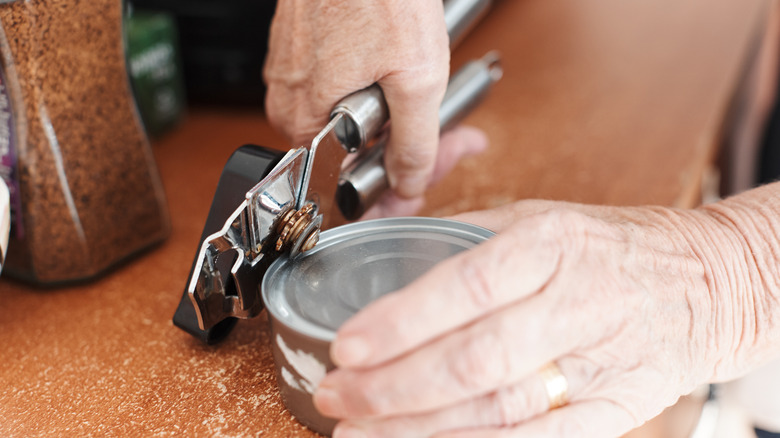De-Grime Your Dirty Can Opener With A Handy Staple You Already Own
Some of us are old school and like to open our cans of tuna one turn at a time using a manual can opener. One advantage of a manual versus an electric can opener is that a manual opener is easier to clean, yet somehow, we may neglect to do so. Little bits of gunk can accumulate on the blades, making it harder to turn and potentially attracting bacteria. At a microscopic level, we transfer the juices from one can into the contents of the next. So even though you may not taste a difference if you open the tuna and then open the chickpeas, a rinse in between uses is important. Rinsing can de-juice your opener, but you might need a little extra cleaning boost.
The good news is there's a super-quick fix you can use with a staple already in your kitchen; paper towels to the rescue. This is a very simple hack that can de-gunk your can opener in under a minute. And while regular cleaning is crucial, after their years of service, you should also replace this item regularly.
How to de-grime your can open with paper towels
First, get your resources together. For this hack, all you need is your can opener and a full sheet of paper towel that you fold lengthwise into thirds or fourths. You should end up with a thick rectangle of paper towel. Position the can opener's blades around the paper towel at the top and start turning the handle. You should see gunk deposited onto the paper. What to watch out for — after you remove the paper towel, which will get a little wound up in your can's blades, examine it closely for left behind bits of paper towel and remove them.
Here is a bonus tip that requires using a different household staple. It also cleans the can opener's blades and offers the secondary benefit of lubricating them. Instead of a paper towel, grab a piece of wax paper and fold it into thirds to get a nice thick piece to work with. Starting at the top, run your can opener through it. This also cleans off debris, plus it leaves a trace amount of food-grade wax behind, making the blades easier to turn. Turn the wax paper to get a clean edge and repeat until clean. And, of course, as a best practice, don't underestimate the power of cleaning your blades after each use with soapy dishwashing liquid and a toothbrush.
